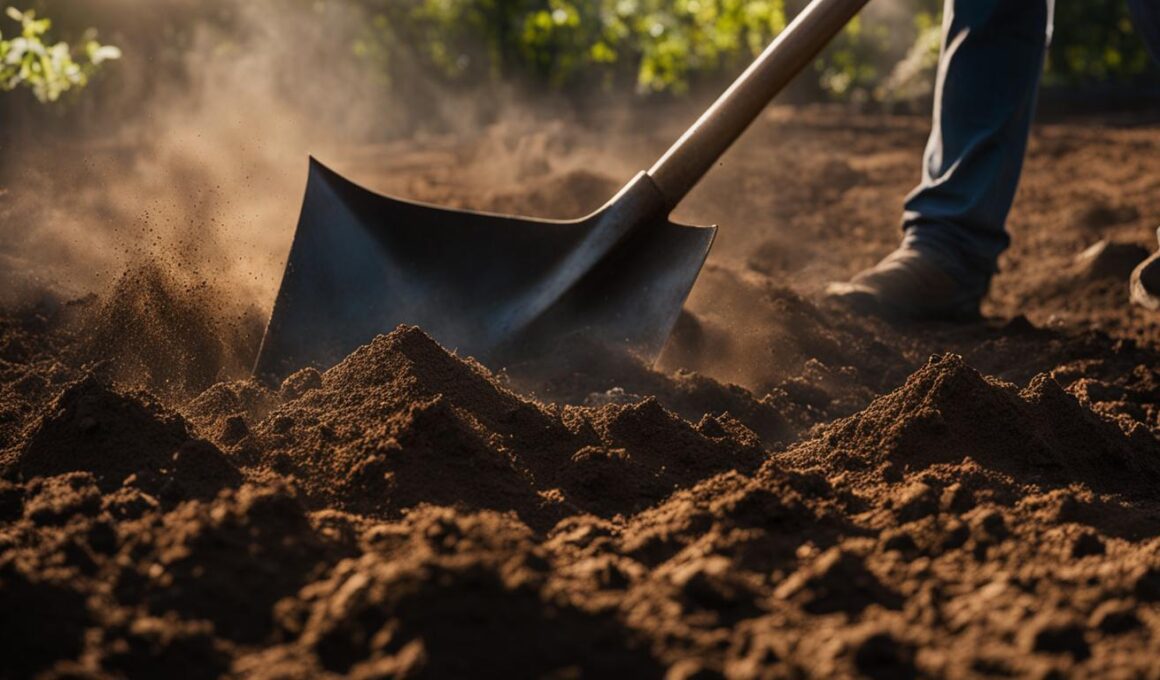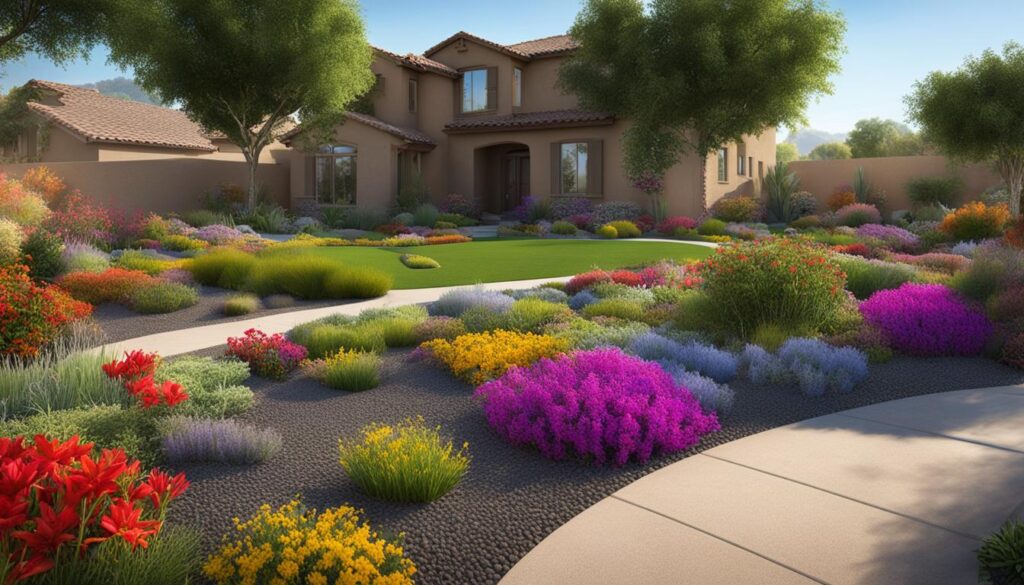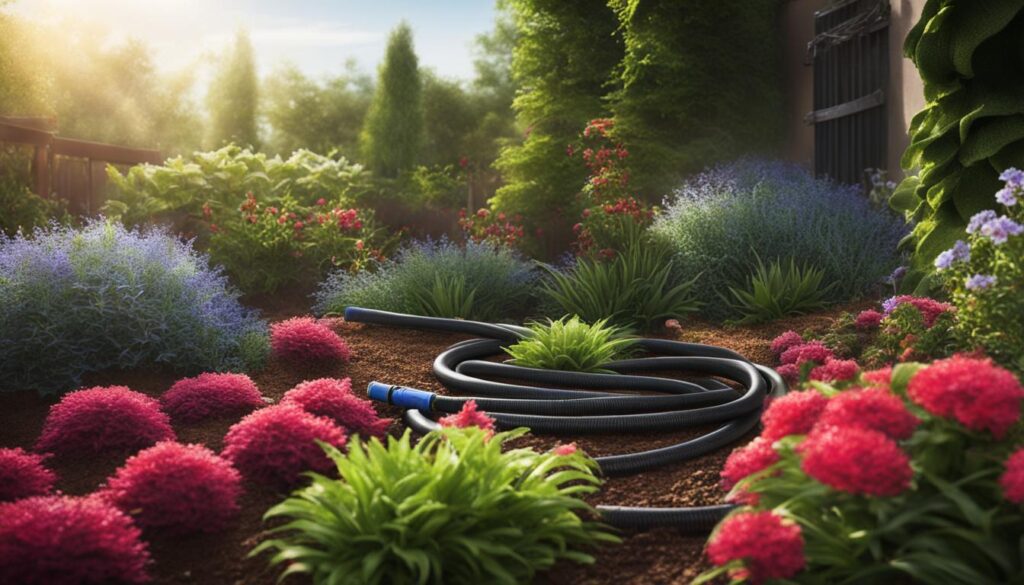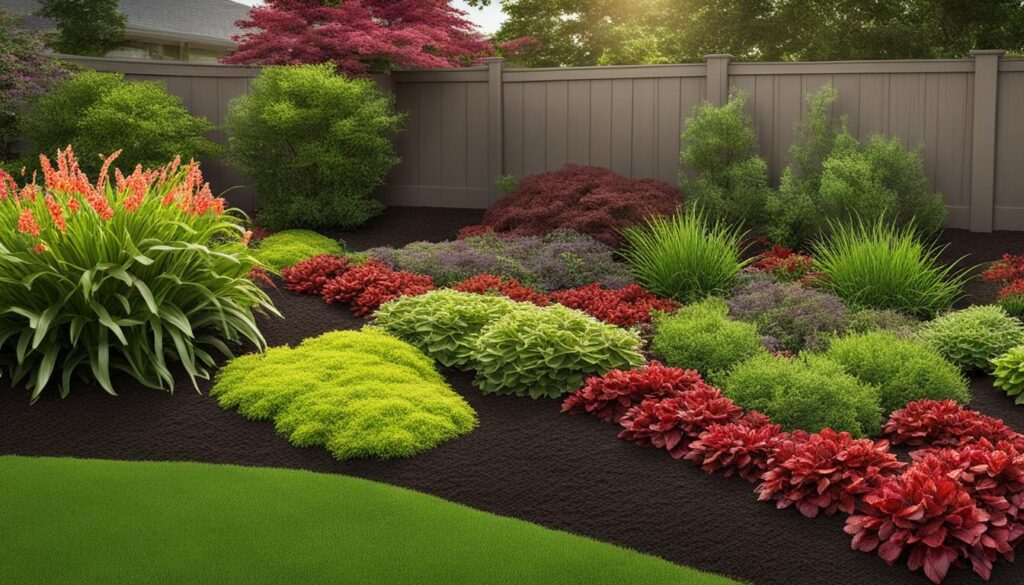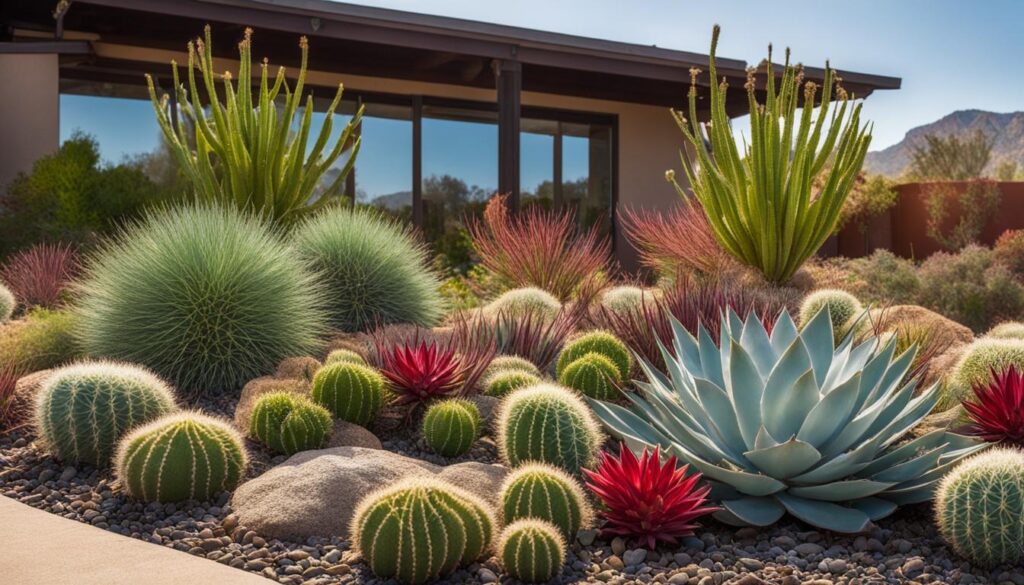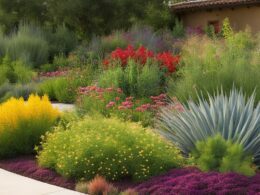Are you looking to create a beautiful and water-efficient garden? Xeriscaping, a landscaping technique that focuses on water conservation, is the answer. And when it comes to xeriscaping, soil aeration practices are key to enhancing your garden’s health and vitality.
By improving soil structure and increasing oxygen levels, soil aeration promotes better water infiltration, root growth, and overall plant health. Whether you’re a seasoned gardener or just starting out, implementing soil aeration techniques can make a significant difference in the success of your xeriscape garden.
So, let’s dive deeper into the world of soil aeration and discover how it can boost your xeriscape garden and help you conserve water.
Key Takeaways
- Soil aeration is crucial for creating healthy and water-efficient gardens in xeriscaping.
- Improving soil structure and increasing oxygen levels promotes better water infiltration and root growth.
- Soil aeration techniques, such as core aeration or vertical mulching, loosen compacted soil and stimulate beneficial microbial activity.
- Xeriscaping with soil aeration practices conserves water and creates a sustainable and visually appealing landscape.
- By incorporating soil aeration into your xeriscape garden, you can enjoy the benefits of reduced maintenance and increased plant health.
Understanding Xeriscaping and Its Importance
Xeriscaping is a landscaping approach that focuses on designing gardens with water conservation as a primary goal. It involves using plants that are adapted to dry conditions and implementing techniques to reduce water usage. By understanding the principles and importance of xeriscaping, you can create a beautiful and sustainable garden that saves water and minimizes maintenance efforts.
The key concept behind xeriscaping is to create a garden that is well-suited to the local climate and requires minimal irrigation. This is achieved by choosing drought-tolerant plants that can survive with less water. These plants have adapted to arid conditions and have developed mechanisms to store water and withstand periods of drought. By incorporating these plants into your garden, you can greatly reduce the amount of water needed for irrigation.
Xeriscaping is important not only for water conservation but also for reducing maintenance efforts. Traditional gardens often require regular watering, mowing, and fertilizing. These tasks can be time-consuming and can contribute to water waste and pollution. In contrast, xeriscaping minimizes the need for irrigation and reduces the use of pesticides and fertilizers. This means less time spent on maintenance and a more environmentally-friendly garden.
“Xeriscaping is a landscaping approach that focuses on designing gardens with water conservation as a primary goal.”
Benefits of Xeriscaping
- Water Conservation: By using drought-tolerant plants and implementing water-saving techniques, xeriscaping significantly reduces water usage and helps conserve this precious resource.
- Low Maintenance: Xeriscape gardens require less maintenance compared to traditional gardens, saving you time, effort, and money.
- Environmental Sustainability: Xeriscaping promotes sustainability by reducing water waste, minimizing the use of chemicals, and providing habitat for native wildlife.
- Visual Appeal: With careful planning and design, xeriscape gardens can be just as visually appealing as traditional gardens, showcasing the beauty of drought-tolerant plants and creative landscaping.
Understanding xeriscaping and its importance is the first step towards creating a water-efficient and sustainable garden. By implementing xeriscaping principles, you can contribute to water conservation efforts, reduce your environmental impact, and enjoy the beauty of a well-designed and low-maintenance landscape.
Image source: https://seowriting.ai/32_6.png
Planning Your Xeriscape Garden
When it comes to creating a successful xeriscape garden, careful planning is key. By considering factors such as water exposure, slope, and soil type, you can design a garden that maximizes water efficiency and thrives in dry conditions.
Water Exposure
Start by assessing the water exposure of your garden site. Southern and western exposures tend to have higher water losses due to increased sunlight and heat. These areas may require additional water-efficient strategies, such as planting drought-tolerant shrubs or using strategic shading techniques to reduce evaporation.
Slope and Drainage
The slope of your garden plays a crucial role in water runoff and drainage. Steep slopes can lead to rapid water runoff and erosion. Consider implementing contouring techniques or terracing to slow down water flow and retain moisture. Additionally, understanding your soil type can help determine its drainage capacity and guide your choice of plants and irrigation methods.
Choosing the Right Plants
Selecting the right plants for your xeriscape garden is essential for water efficiency. Look for drought-tolerant species that are adapted to your region’s climate and soil conditions. Native plants are often excellent choices as they are well-suited to the local ecosystem, requiring less water and maintenance. Grouping plants with similar water needs together can also optimize irrigation and conserve water.
| Plant | Water Needs | Sunlight Requirements |
|---|---|---|
| Lavender | Low | Full sun |
| Yarrow | Low | Full sun to part shade |
| Salvia | Low to moderate | Full sun |
| Penstemon | Low to moderate | Full sun to part shade |
By carefully planning your xeriscape garden, taking into account the water exposure, slope, and soil type, you can create a beautiful and water-efficient landscape that thrives in dry conditions. Choosing the right plants and implementing strategic irrigation methods will help conserve water and minimize maintenance efforts, allowing you to enjoy a stunning garden while supporting sustainable water conservation.
Reducing the Use of Irrigated Turf
One of the key principles of xeriscaping is to reduce the use of irrigated turf. By minimizing or eliminating narrow strips of turf, hard-to-maintain corners, and isolated islands of grass, you can significantly contribute to water conservation in your garden. Not only does this practice save water, but it also reduces maintenance costs and creates space for more water-efficient plantings.
Irrigated turf requires regular watering, which can contribute to excess water consumption. By transitioning away from large areas of turf, you can design a more sustainable and water-wise landscape. Instead, consider incorporating alternative ground covers, such as gravel, mulch, or native plants, which require less water and maintenance.
In addition to conserving water, reducing the use of irrigated turf offers other benefits. It minimizes the need for fertilizers and pesticides, reducing potential environmental pollution. It also saves time and effort spent on mowing, weeding, and other lawn care tasks. By embracing xeriscaping and minimizing irrigated turf, you can create a beautiful and environmentally-friendly garden.
Benefits of Reducing Irrigated Turf
Reducing the use of irrigated turf offers several advantages:
- Water Conservation: By replacing turf with water-efficient alternatives, you save significant amounts of water.
- Cost Savings: Less turf means lower water bills and reduced maintenance expenses.
- Environmental Sustainability: Minimizing irrigated turf helps conserve water resources and promotes ecological balance.
- Enhanced Aesthetics: By incorporating diverse plants and ground covers, you can create a visually appealing and vibrant landscape.
“Reducing the use of irrigated turf is not only beneficial for water conservation but also contributes to a more sustainable and beautiful garden.”
Comparative Analysis: Turf vs. Water-Efficient Alternatives
To illustrate the water-saving potential of reducing irrigated turf, let’s compare the water requirements of different landscaping options:
| Turf | Water-Efficient Alternative | |
|---|---|---|
| Water Requirements | High | Low to Moderate |
| Maintenance | Regular mowing, watering, fertilizing, and pest control | Minimal maintenance, less watering and fertilizing |
| Environmental Impact | Excessive water consumption, pesticide and fertilizer runoff | Reduced water usage, less need for chemicals |
| Aesthetics | Uniform green appearance | Diverse textures and colors, native plant diversity |
Table: Comparative Analysis of Turf and Water-Efficient Alternatives
As demonstrated in the table, water-efficient alternatives to turf require less water, have lower maintenance demands, and offer a more diverse and visually appealing landscape. By choosing these alternatives, you can reduce water consumption, minimize environmental impact, and create a sustainable garden that enhances the beauty of your outdoor space.
Soil Preparation for Water Conservation
Proper soil preparation is a key component of water conservation in xeriscaping. By implementing effective soil preparation techniques, you can optimize water retention, improve soil structure, and ensure the healthy growth of your plants.
Promoting Water Retention and Preventing Runoff
A well-prepared soil with good structure and nutrient content helps retain water and prevent runoff. This is crucial for water conservation in xeriscaping. One effective way to enhance water retention is by adding organic matter, such as compost, to the soil. Organic matter improves soil structure, increases its water-holding capacity, and reduces the risk of water loss through runoff.
In addition to organic matter, soil amendment techniques like aeration and deep watering can also contribute to water conservation. Aeration, such as core aeration or vertical mulching, loosens compacted soil, increases pore space, and improves water infiltration. Deep watering involves supplying water directly to the root zone, encouraging deeper root growth and reducing evaporation.
Enhancing Root Growth and Nutrient Uptake
Proper soil preparation not only improves water retention but also enhances root growth and nutrient uptake. Adequate oxygen levels are essential for healthy root development, and soil aeration plays a key role in maintaining oxygen availability. By promoting oxygen diffusion into the soil, aeration techniques stimulate beneficial microbial activity and create an optimal environment for root growth and nutrient absorption.
When preparing your soil, consider the specific requirements of your plants. Different plants thrive in different soil conditions, so it’s crucial to understand the specific needs of the plants you intend to grow in your xeriscape garden. Research the ideal soil structure and nutrient content for your selected plant varieties, and adjust your soil preparation practices accordingly.
Overall, proper soil preparation is a vital aspect of water conservation in xeriscaping. By incorporating techniques like adding organic matter, aerating the soil, and deep watering, you can create an environment that promotes water efficiency, healthy plant growth, and long-term garden success.
Implementing Efficient Irrigation Practices
Efficient irrigation practices are essential in xeriscaping to minimize water waste and ensure optimal plant growth. By using methods such as drip irrigation and soaker hoses, you can deliver water directly to the root zone, reducing evaporation and runoff. This targeted approach to irrigation not only conserves water but also promotes healthier plant development.
Drip irrigation is a highly efficient method that delivers water slowly and directly to the base of plants. It uses a network of tubes with small holes or emitters that release water in controlled amounts, ensuring that the plants receive the necessary moisture without excessive waste. This method is particularly useful for watering individual plants, shrubs, or trees.
Soaker hoses are another effective option in efficient irrigation. These hoses have tiny pores throughout their length, which allow water to seep into the soil gradually. The hoses can be laid along the base of plants or buried slightly under mulch to deliver water directly to the root zone. Soaker hoses are especially useful for watering larger areas or garden beds.
Advantages of Efficient Irrigation Practices:
- Minimize water waste through targeted watering
- Reduce evaporation and runoff
- Promote healthier plant growth and root development
- Save time and effort compared to manual watering methods
- Adjustable for different plant water requirements
“Efficient irrigation practices are crucial in xeriscaping to minimize water waste and ensure optimal plant growth.”
By grouping plants with similar water needs together, you can further optimize water usage in your xeriscape garden. This allows you to tailor the irrigation schedule and amount of water provided to specific plant groups, rather than applying a generic watering approach. Monitoring soil moisture levels and using moisture sensors or timers can also ensure that plants receive water only when needed, preventing overwatering and unnecessary water loss.
Efficient irrigation practices not only conserve water but also contribute to the overall success and sustainability of your xeriscape garden. By implementing these methods, you can create a visually appealing landscape while minimizing the environmental impact of excessive water usage.
Utilizing Organic Mulch for Water Retention
When it comes to water conservation in xeriscaping, utilizing organic mulch is a smart and effective strategy. Organic mulch, such as wood chips or compost, plays a crucial role in retaining water in the soil, promoting healthy plant growth, and reducing the need for frequent watering. It also offers additional benefits like regulating soil temperature and controlling weed growth.
A layer of organic mulch applied around plants acts as a protective barrier, reducing evaporation and preventing moisture loss from the soil. This helps to maintain consistent soil moisture levels and reduces the frequency of irrigation. Additionally, organic mulch insulates the soil, keeping it cooler in hot weather and warmer in cold weather, providing a stable environment for plant roots.
Organic mulch also acts as a natural weed suppressor by blocking sunlight and inhibiting weed seed germination. This reduces the competition for water and nutrients between weeds and desired plants, giving your xeriscape garden an advantage in terms of water efficiency and overall plant health. Make sure to leave space around the stems of plants when applying mulch to prevent moisture-related issues.
| Benefit | Explanation |
|---|---|
| Water Retention | Organic mulch helps retain moisture in the soil, reducing the need for frequent watering. |
| Soil Temperature Regulation | Mulch acts as an insulator, keeping the soil cooler in hot weather and warmer in cold weather. |
| Weed Control | The layer of mulch blocks sunlight and prevents weed seed germination, reducing weed competition for water and nutrients. |
To maximize the benefits of organic mulch, apply a layer of 2-4 inches around your plants, extending it to the drip line (the outermost edge of the plant’s canopy). This will cover the root zone and effectively retain moisture. However, avoid piling mulch against the stems of plants, as this can cause excess moisture and potential rotting. Regularly replenish the mulch layer as it decomposes over time to maintain its effectiveness.
Choose the Right Organic Mulch
When selecting organic mulch for your xeriscape garden, consider its availability, cost, and suitability for your specific plant types. Wood chips, bark, straw, and compost are popular choices that provide excellent water retention and weed control. Avoid using materials like grass clippings, as they can form a dense mat that inhibits water penetration.
By utilizing organic mulch in your xeriscape garden, you can significantly improve water retention, reduce watering needs, and create a healthier and more sustainable landscape. It’s a simple yet effective technique that aligns with the principles of xeriscaping and contributes to water conservation efforts.
Choosing Drought-Tolerant and Native Plants
When it comes to xeriscaping, selecting the right plants is crucial for creating a water-efficient and sustainable garden. Drought-tolerant plants are specially adapted to thrive in dry conditions, requiring less water for growth and survival. These plants have deep root systems that allow them to access water from deeper soil layers, making them more resilient during periods of water scarcity. By incorporating drought-tolerant plants into your xeriscape garden, you can significantly reduce your water consumption and ensure long-term plant health.
Native plants are another excellent choice for xeriscaping. These plants are naturally found in your local ecosystem and have evolved to thrive in your specific climate and soil conditions. By using native plants in your garden, you can create a sustainable habitat that supports local wildlife, including birds, bees, and butterflies. Additionally, native plants are well-adapted to your region’s rainfall patterns, making them an ideal choice for water-efficient landscaping. Their ability to withstand local weather conditions reduces the need for supplemental watering, further conserving water resources.
When selecting drought-tolerant and native plants for your xeriscape garden, consider factors such as sun exposure, soil type, and maintenance requirements. Choose plants that are well-suited to your site’s conditions, ensuring they will thrive with minimal water inputs. Grouping plants with similar water needs together can also help streamline your watering routine and ensure efficient water usage. Remember to research local plant species and consult with a local horticulturist or gardening expert to determine the best plants for your specific region.
Benefits of Drought-Tolerant and Native Plants in Xeriscaping
There are several benefits to incorporating drought-tolerant and native plants into your xeriscape garden:
- Water conservation: Drought-tolerant plants require less water, reducing your overall water consumption and promoting sustainable water management.
- Low maintenance: Once established, drought-tolerant and native plants have lower maintenance needs, saving you time and effort in garden upkeep.
- Biodiversity: Native plants provide habitat for local wildlife and support biodiversity, contributing to a healthier and more balanced ecosystem.
- Visual appeal: Many drought-tolerant and native plants offer beautiful blooms, textures, and colors, creating an aesthetically pleasing landscape.
- Environmental sustainability: By reducing the need for water, fertilizers, and pesticides, xeriscaping with drought-tolerant and native plants helps protect the environment and reduce pollution.
By carefully selecting and incorporating drought-tolerant and native plants into your xeriscape garden, you can create a beautiful, water-efficient, and eco-friendly landscape that benefits both you and the environment.
“Planting native species in your xeriscape garden not only helps conserve water but also supports the local ecosystem by providing habitat for native insects, birds, and other wildlife.” – Gardening Expert
Proper Maintenance for Long-Term Success
Maintaining your xeriscape garden is key to its long-term success. By following proper maintenance practices, you can ensure the health and vitality of your plants while maximizing water efficiency. This section will guide you through essential maintenance tasks such as watering, pruning, and weed control.
Watering
Watering your xeriscape garden requires careful attention. As plants become established, their water requirements may decrease. However, it’s important to monitor soil moisture levels and adjust your watering practices accordingly. One way to do this is by using moisture sensors or timers to determine when plants need to be watered. Additionally, grouping plants with similar water needs together can help optimize water usage.
Pruning
Regular pruning is essential to maintain the shape and health of your xeriscape plants. Prune dead or damaged branches to promote new growth and remove any overgrown or tangled branches that may impede the plant’s growth. It’s also important to prune your plants at the right time, depending on their specific needs. Proper pruning techniques will not only enhance the aesthetic appeal of your garden but also encourage better air circulation and reduce the risk of disease.
Weed Control
Weeds can compete with your xeriscape plants for water and nutrients, so effective weed control is crucial. Regularly inspect your garden for weeds and remove them promptly to prevent them from spreading. Mulching the soil surface with organic mulch can also help suppress weed growth and conserve soil moisture. Applying a layer of mulch around your plants, leaving space around the stems, creates a barrier that inhibits weed germination and reduces the need for excessive weeding.
| Maintenance Task | Frequency | Benefits |
|---|---|---|
| Watering | As needed | Ensures plant health and water efficiency |
| Pruning | Seasonal or as needed | Promotes plant growth and aesthetic appeal |
| Weed Control | Regularly | Prevents competition for water and nutrients |
By dedicating time to proper maintenance, your xeriscape garden will thrive and continue to be a beautiful and water-efficient oasis for years to come.
Enhancing Soil Health with Aeration Practices
Soil aeration plays a significant role in enhancing soil health in xeriscaping. By improving oxygen levels and promoting better water infiltration, soil aeration creates an optimal environment for root growth and nutrient absorption. Aeration techniques, such as core aeration or vertical mulching, loosen compacted soil, increase pore space, and stimulate beneficial microbial activity. Regular soil aeration helps maintain healthy and water-efficient gardens.
When soil becomes compacted, it restricts the movement of air, water, and nutrients, negatively impacting plant health. Aeration helps alleviate compaction by creating channels in the soil, allowing oxygen to reach the roots and facilitating the exchange of gases. Oxygen is vital for root respiration, enabling plants to absorb nutrients and thrive. Improved water infiltration resulting from soil aeration prevents waterlogging and reduces the risk of diseases caused by excess moisture.
Core aeration is a commonly used technique in xeriscaping to alleviate compaction. It involves removing small plugs of soil from the turf or garden bed, creating openings for air and water penetration. Vertical mulching, on the other hand, utilizes deep holes to break up compacted soil layers and enhance root growth. Both techniques improve soil structure, increase water-holding capacity, and promote the development of a robust and healthy root system.
Benefits of Soil Aeration in Xeriscaping
- Promotes better water infiltration and drainage
- Enhances oxygen levels for improved root respiration and nutrient absorption
- Loosens compacted soil, allowing for better root penetration and growth
- Stimulates beneficial microbial activity in the soil
- Reduces the risk of waterlogging and diseases caused by excess moisture
- Improves overall soil health and fertility
Incorporating regular soil aeration practices into your xeriscape garden maintenance routine is crucial for long-term success. By creating an oxygen-rich environment and promoting water infiltration, soil aeration helps ensure the health and vitality of your plants, resulting in a beautiful and water-efficient landscape.
The Environmental Benefits of Xeriscaping
Xeriscaping offers numerous environmental benefits that make it a sustainable and eco-friendly landscaping approach. By implementing water conservation practices, xeriscaping reduces the strain on local water resources and promotes responsible water management. With the increasing scarcity of water in many regions, xeriscaping plays a crucial role in conserving this precious resource.
One of the significant environmental benefits of xeriscaping is the creation of wildlife habitat. By selecting native plants that are adapted to the local ecosystem, xeriscape gardens provide food and shelter for native wildlife. These gardens act as havens for birds, butterflies, bees, and other pollinators, contributing to biodiversity conservation and promoting a thriving ecosystem.
Not only does xeriscaping conserve water and support wildlife, but it also reduces the use of harmful chemicals. With the limited need for pesticides and fertilizers, xeriscape gardens minimize pollution and create a healthier environment. Additionally, the reduced use of gas-powered mowers decreases air and noise pollution, making xeriscaping a greener and more sustainable alternative to traditional landscaping practices.
In summary, xeriscaping offers significant environmental benefits, including water conservation, wildlife habitat creation, and reduced use of harmful chemicals and pollutants. By implementing xeriscaping techniques in our gardens, we can contribute to a more sustainable and eco-friendly future.
Table 11-1: Environmental Benefits of Xeriscaping
| Benefit | Description |
|---|---|
| Water conservation | Reduces strain on local water resources and promotes responsible water management. |
| Wildlife habitat creation | Provides food and shelter for native wildlife, promoting biodiversity. |
| Reduction in chemical use | Minimizes the need for pesticides and fertilizers, reducing pollution. |
| Decreased pollution | Reduces air and noise pollution through limited use of gas-powered mowers. |
“Xeriscaping not only conserves water and supports wildlife, but also reduces the use of harmful chemicals and pollutants.”
By embracing xeriscaping and its environmental benefits, we can contribute to a more sustainable and resilient planet. Whether you have a small garden or a large landscape, implementing xeriscaping techniques can make a significant difference in conserving water and creating a thriving ecosystem. Let’s take the step towards a greener future with xeriscaping!
How Does Soil Erosion Control in Xeriscaping Impact Soil Aeration Practices?
Soil erosion control in xeriscaping has a significant impact on soil aeration practices. By utilizing drought-tolerant plants and mulch, xeriscaping helps to maintain soil structure, preventing compaction and promoting proper soil aeration. This ultimately supports healthier plant growth and overall soil health.
Conclusion
Xeriscaping is a practical and environmentally-friendly approach to landscaping that focuses on water conservation and sustainable gardening practices. By incorporating soil aeration practices, selecting appropriate plants, and implementing efficient irrigation and maintenance techniques, you can create a beautiful and water-efficient garden.
With xeriscaping, you not only conserve water but also contribute to a greener and more sustainable future. By improving soil structure and increasing oxygen levels through soil aeration, you promote better water infiltration, root growth, and overall plant health. This not only benefits your garden but also helps in conserving water resources.
Embracing xeriscaping saves water and money while creating visually appealing and sustainable landscapes. So, whether you have a small backyard garden or a larger landscape, consider implementing xeriscaping principles to create a more water-efficient and environmentally-friendly garden.





